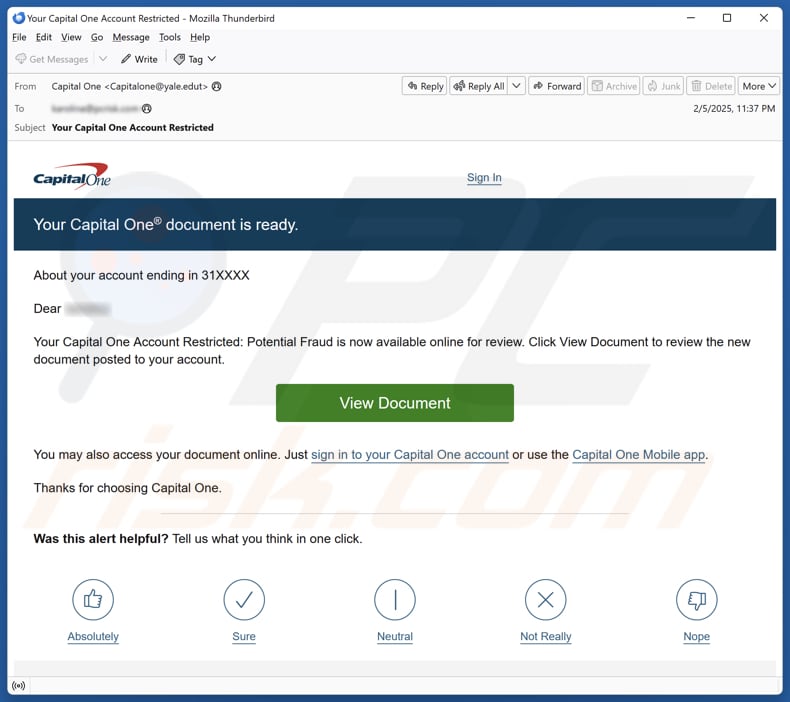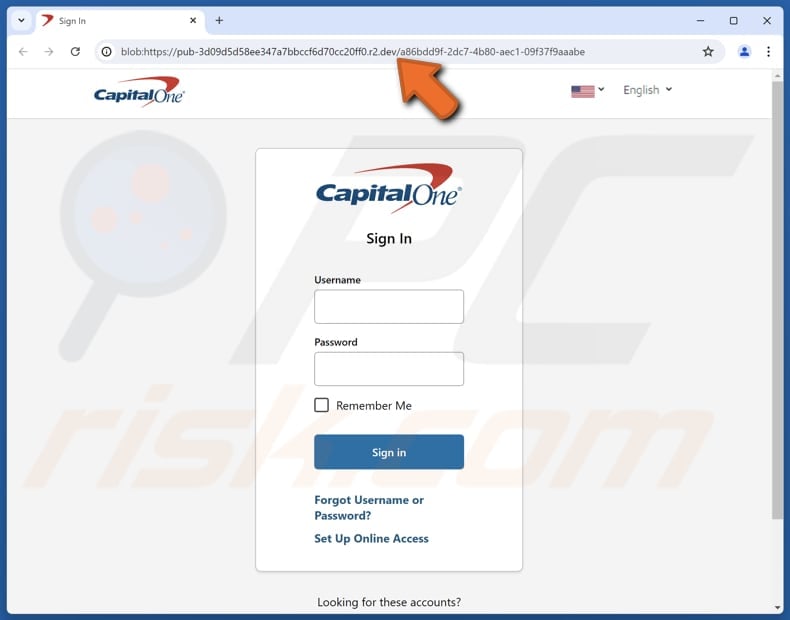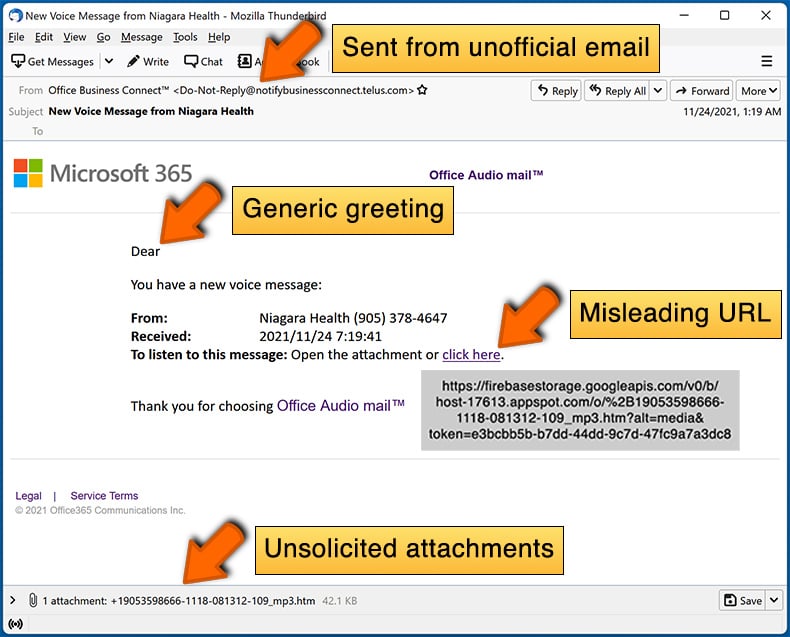How to identify scams like "Capital One - Document Is Ready"
Phishing/ScamAlso Known As: Capital One - Document Is Ready phishing email
Get free scan and check if your device is infected.
Remove it nowTo use full-featured product, you have to purchase a license for Combo Cleaner. Seven days free trial available. Combo Cleaner is owned and operated by RCS LT, the parent company of PCRisk.com.
What kind of scam is "Capital One - Document Is Ready"?
Our team has examined the email and discovered that it is a fake notification supposedly sent by Capital One, a legitimate bank holding company. It is designed to deceive unsuspecting recipients into opening a fake website and revealing personal information. This email should be ignored.

More about the "Capital One - Document Is Ready" scam email
The phishing email claims that the recipient's Capital One account has been restricted due to potential fraud. It urges the recipient to click a link labeled "View Document" to review the document related to their account. The email provides an alternative to access the document through the recipient's Capital One account or mobile app.
Clicking the "View Document", "sign in to your Capital One account" or "Capital One Mobile app" button or link leads to a phishing web page disguised as the Capital One account login site. This page is designed to lure visitors into entering their usernames and passwords to "sign in". If entered, this information is sent to scammers.
If scammers manage to steal Capital One account credentials, they may access the victim's account and steal sensitive financial details or carry out unauthorized transactions. They may also attempt to use these credentials across multiple websites, assuming the victim uses the same login information elsewhere.
If successful, this could lead to access to additional accounts, such as email or social media, which could be exploited for malicious activities like sending phishing emails, distributing malware, or gathering more personal data. Furthermore, stolen account details may be sold on the dark web. For these reasons, it is crucial to avoid interacting with suspicious emails.
| Name | Capital One - Document Is Ready Email Scam |
| Threat Type | Phishing, Scam, Social Engineering, Fraud |
| Fake Claim | Access to Capital One account is restricted |
| Disguise | Notification from Capital One |
| Symptoms | Generic greeting, urgent language, suspicious links, grammatical errors. |
| Distribution methods | Deceptive emails, rogue online pop-up ads, search engine poisoning techniques, misspelled domains. |
| Damage | Loss of sensitive private information, monetary loss, identity theft. |
| Malware Removal (Windows) |
To eliminate possible malware infections, scan your computer with legitimate antivirus software. Our security researchers recommend using Combo Cleaner. Download Combo CleanerTo use full-featured product, you have to purchase a license for Combo Cleaner. 7 days free trial available. Combo Cleaner is owned and operated by RCS LT, the parent company of PCRisk.com. |
Similar scam emails in general
These emails are usually scams designed to steal personal information by impersonating legitimate companies, services, or other entities. They often create a false sense of urgency, include links to fraudulent websites, or ask users to provide sensitive details directly. In some cases, they may also serve as a method to distribute malware.
Examples of phishing emails are "Account Is Due For Update", "Emirates NBD - Secure Banking Notification", and "Capital One - Secured Message".
How do spam campaigns infect computers?
Cybercriminals distribute malware via email by attaching infected files or embedding malicious links. The malware can be triggered if a recipient opens these files or enables features like macros in documents. Attackers use various formats, including PDFs, executables, ISO files, scripts, and compressed archives.
Fraudulent emails may also lead users to unsafe websites that either initiate automatic malware downloads or trick them into manually installing harmful software. Ultimately, these tactics depend on deceiving users into actions that compromise their security.
How to avoid installation of malware?
Be cautious with unexpected emails from unknown senders, especially those containing attachments or links—avoid opening or interacting with them. Always download software only from official websites or trusted app stores, as other (questionable) sources may distribute malicious or unwanted programs.
Avoid clicking pop-ups, buttons, or links on suspicious websites. Keep your operating system and software updated, and regularly scan your device with a reputable security tool to detect potential threats. If you have already opened malicious attachments, we recommend running a scan with Combo Cleaner Antivirus for Windows to automatically eliminate infiltrated malware.
Text presented in the "Capital One - Document Is Ready" email letter:
Subject: Your Capital One Account Restricted
Visit Capital One Sign In
Your Capital One® document is ready.About your account ending in 31XXXX
Dear -,
Your Capital One Account Restricted: Potential Fraud is now available online for review. Click View Document to review the new document posted to your account.
View DocumentYou may also access your document online. Just sign in to your Capital One account or use the Capital One Mobile app.
Thanks for choosing Capital One.
Was this alert helpful? Tell us what you think in one click.
Phishing website used in this scam:

Instant automatic malware removal:
Manual threat removal might be a lengthy and complicated process that requires advanced IT skills. Combo Cleaner is a professional automatic malware removal tool that is recommended to get rid of malware. Download it by clicking the button below:
DOWNLOAD Combo CleanerBy downloading any software listed on this website you agree to our Privacy Policy and Terms of Use. To use full-featured product, you have to purchase a license for Combo Cleaner. 7 days free trial available. Combo Cleaner is owned and operated by RCS LT, the parent company of PCRisk.com.
Quick menu:
- What is Capital One - Document Is Ready phishing email?
- Types of malicious emails.
- How to spot a malicious email?
- What to do if you fell for an email scam?
Types of malicious emails:
![]() Phishing Emails
Phishing Emails
Most commonly, cybercriminals use deceptive emails to trick Internet users into giving away their sensitive private information, for example, login information for various online services, email accounts, or online banking information.
Such attacks are called phishing. In a phishing attack, cybercriminals usually send an email message with some popular service logo (for example, Microsoft, DHL, Amazon, Netflix), create urgency (wrong shipping address, expired password, etc.), and place a link which they hope their potential victims will click on.
After clicking the link presented in such email message, victims are redirected to a fake website that looks identical or extremely similar to the original one. Victims are then asked to enter their password, credit card details, or some other information that gets stolen by cybercriminals.
![]() Emails with Malicious Attachments
Emails with Malicious Attachments
Another popular attack vector is email spam with malicious attachments that infect users' computers with malware. Malicious attachments usually carry trojans that are capable of stealing passwords, banking information, and other sensitive information.
In such attacks, cybercriminals' main goal is to trick their potential victims into opening an infected email attachment. To achieve this goal, email messages usually talk about recently received invoices, faxes, or voice messages.
If a potential victim falls for the lure and opens the attachment, their computers get infected, and cybercriminals can collect a lot of sensitive information.
While it's a more complicated method to steal personal information (spam filters and antivirus programs usually detect such attempts), if successful, cybercriminals can get a much wider array of data and can collect information for a long period of time.
![]() Sextortion Emails
Sextortion Emails
This is a type of phishing. In this case, users receive an email claiming that a cybercriminal could access the webcam of the potential victim and has a video recording of one's masturbation.
To get rid of the video, victims are asked to pay a ransom (usually using Bitcoin or another cryptocurrency). Nevertheless, all of these claims are false - users who receive such emails should ignore and delete them.
How to spot a malicious email?
While cyber criminals try to make their lure emails look trustworthy, here are some things that you should look for when trying to spot a phishing email:
- Check the sender's ("from") email address: Hover your mouse over the "from" address and check if it's legitimate. For example, if you received an email from Microsoft, be sure to check if the email address is @microsoft.com and not something suspicious like @m1crosoft.com, @microsfot.com, @account-security-noreply.com, etc.
- Check for generic greetings: If the greeting in the email is "Dear user", "Dear @youremail.com", "Dear valued customer", this should raise suspiciousness. Most commonly, companies call you by your name. Lack of this information could signal a phishing attempt.
- Check the links in the email: Hover your mouse over the link presented in the email, if the link that appears seems suspicious, don't click it. For example, if you received an email from Microsoft and the link in the email shows that it will go to firebasestorage.googleapis.com/v0... you shouldn't trust it. It's best not to click any links in the emails but to visit the company website that sent you the email in the first place.
- Don't blindly trust email attachments: Most commonly, legitimate companies will ask you to log in to their website and to view any documents there; if you received an email with an attachment, it's a good idea to scan it with an antivirus application. Infected email attachments are a common attack vector used by cybercriminals.
To minimise the risk of opening phishing and malicious emails we recommend using Combo Cleaner Antivirus for Windows.
Example of a spam email:

What to do if you fell for an email scam?
- If you clicked on a link in a phishing email and entered your password - be sure to change your password as soon as possible. Usually, cybercriminals collect stolen credentials and then sell them to other groups that use them for malicious purposes. If you change your password in a timely manner, there's a chance that criminals won't have enough time to do any damage.
- If you entered your credit card information - contact your bank as soon as possible and explain the situation. There's a good chance that you will need to cancel your compromised credit card and get a new one.
- If you see any signs of identity theft - you should immediately contact the Federal Trade Commission. This institution will collect information about your situation and create a personal recovery plan.
- If you opened a malicious attachment - your computer is probably infected, you should scan it with a reputable antivirus application. For this purpose, we recommend using Combo Cleaner Antivirus for Windows.
- Help other Internet users - report phishing emails to Anti-Phishing Working Group, FBI’s Internet Crime Complaint Center, National Fraud Information Center and U.S. Department of Justice.
Frequently Asked Questions (FAQ)
Why did I receive this email?
Typically, scammers send these messages to many people without personalizing them. They usually collect email addresses from public sources, data leaks, or fake websites.
I have provided my personal information when tricked by this email, what should I do?
If you have shared personal information, update your passwords immediately. Also, reach out to the affected service(s), like your bank, to report the issue.
I have downloaded and opened a malicious file attached to an email, is my computer infected?
The probability of infection depends on the file type. If an executable file is opened, there is a high chance your system is compromised. If it is a document, the risk is lower (malicious MS Office documents may not infect systems if macros are not enabled).
I have read the email but did not open the attachment, is my computer infected?
Opening an email is generally safe, but clicking malicious links or opening infected attachments can expose devices to malware.
Will Combo Cleaner remove malware infections that were present in email attachment?
Combo Cleaner can identify and eliminate most known malware, but more advanced threats may hide deeper within your system. To ensure complete removal, it is recommended to run a full system scan.
Share:

Tomas Meskauskas
Expert security researcher, professional malware analyst
I am passionate about computer security and technology. I have an experience of over 10 years working in various companies related to computer technical issue solving and Internet security. I have been working as an author and editor for pcrisk.com since 2010. Follow me on Twitter and LinkedIn to stay informed about the latest online security threats.
PCrisk security portal is brought by a company RCS LT.
Joined forces of security researchers help educate computer users about the latest online security threats. More information about the company RCS LT.
Our malware removal guides are free. However, if you want to support us you can send us a donation.
DonatePCrisk security portal is brought by a company RCS LT.
Joined forces of security researchers help educate computer users about the latest online security threats. More information about the company RCS LT.
Our malware removal guides are free. However, if you want to support us you can send us a donation.
Donate
▼ Show Discussion